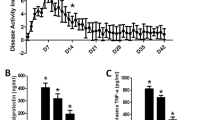Abstract
Substance P content was determined by radioimmunoassay in colonic mucosa from 24 patients with chronic severe constipation, 16 with active ulcerative colitis, and 28 normal controls. In patients with chronic severe constipation, the mean concentration of substance P (19.9±8.2 pg/mg) was significantly lower than in normal subjects (71±18 pg/mg). In patients with ulcerative colitis, colonic substance P concentration in inflamed mucosa (170±46 pg/mg) was significantly higher than its levels in normal subjects. Substance P may therefore have a role in the pathogenesis of clinical conditions associated with diarrhea and constipation.
Similar content being viewed by others
References
De Vroede G: Constipation: Mechanisms and management.In Gastrointestinal Disease, 3rd ed., Vol 1. M Sleisenger, JS Fordtran (eds). Philadelphia, WB Saunders, 1983, p 288.
Haubrich WS: Constipation:In Bockus Gastroenterology, 4th ed., Vol 1. JE Berk (ed). Philadelphia, WB Saunders, 1985, p. 113
Bartho L, Holzer P: Search for a physiological role of substance P in gastrointestinal motility. Neuroscience 16:1–32, 1985
Llewellyn-Smith IJ, Furness JB, Murphy R, O'Brien PE, Costa M: Substance P-containing nerves in the human small intestine. Gastroenterology 86:421–435, 1984
McFadden D, Zinner MJ, Jaffe BM: Substance P-induced intestinal secretion of water and electrolytes. Gut 27:267–272, 1986
Silkoff P, Karmeli F, Goldin E, Ewenson A, Gilon C, Chorev M, Laufer R, Selinger Z, Rachmilewitz D: Effect of substance P in rat gastrointestinal transit. Dig Dis Sci 33:74–77, 1988
Konturek SJ, Jaworek J, Tasler J, Cieszdowski M, Pawlik W: Effect of substance P and its C-terminal hexapeptide on gastric and pancreatic secretion in dog. Am J Physiol 214: G74-G81, 1981
Laufer R, Ewenson A, Gilon C, Chorev M, Selinger Z: Inhibition of substance P degradation in rat brain preparation by peptide hydroxamic acids. Eur J Biochem 150:135–140, 1985
Mantyh PW, Goedert M, Hunt SP: Autoradiographic visualization of receptor binding sites for substance P in the gastrointestinal tract of the guinea pig. Eur J Pharmacol 100: 133–134, 1984
Bradin E, Sjolund K, Hakanson R, Sundler F: Substance P-containing nerve fibers are numerous in human but not in feline intestinal mucosa. Gastroenterology 85:557–564, 1983
Martenson HG, Akande B, Yeo Ch, Jaffe BM: The role of substance P in the control of gastric acid secretion. Surgery 95:567–571, 1984
Donnerer J, Bartho L, Holzer P, Lembeck F: Intestinal peristalsis associated with release of immunoreactive substance P. Neuroscience 11:913–918, 1984
Holzer P, Lembeck F: Effect of neuropeptides on the efficiency of the peristaltic reflex. Naunyn-Schmiedeberg's Arch Pharmacol 307:257–264, 1979
Keast JR, Furness JB, Acosta M: Different substance P receptors are found on mucosal epithelial cells and submucous neurons of the guinea-pig small intestine. NaunynSchmiedeberg's Arch Pharmacol 329:382–387, 1985
Long RG, Barnes AJ, O'Snaughnessy DJ, Bannister R, Bishop AE, Albuquerque RH, McGregor GP, Polak JM, Bloom SR: Neural and hormonal peptides in rectal biopsy specimens from patients with Chagas' disease and chronic autonomic failure. Lancet 1:559–562, 1980
Powel D, Cannon P, Skrabanek P, Kirrane J: The pathophysiology of substance P in man.In Gut Hormones. SR Bloom (ed). Edinburgh, Churchill Livingstone, 1978, pp 525–529
Domschke S, Adrian TE, Bloom SR, Lux G, Bryant MG, Domschke W: VIP, substance P and gastrin levels of gastroduodenal mucosa in celiac sprue. Gastroenterology 82: 1044, 1982 (abstract)
Sjolund K, Schafalitzky OBM, Fahrenkrug J, Hakanson R, Peterson BG, Sundler F: Peptide-containing nerve fibers in the gut wall in Crohn's disease. Gut 24:724–733, 1983
Koch TR, Carney JA, Go VLW: Distribution and quantitation of gut peptides in normal colon and ulcerative colitis. Gastroenterology 86:1139, 1984 (abstract)
Levine JD, Clark R, Devor M, Helms C, Moskowitz MA, Basbaum AI: Intraneural substance P contributes to the severity of experimental arthritis. Science 226:547–549, 1984
Reynolds JC, Ouyang A, Lee AC, Baker L, Sunshine AG, Cohen S: Chronic severe constipation. Gastroenterology 92: 414–420, 1987
Author information
Authors and Affiliations
Rights and permissions
About this article
Cite this article
Goldin, E., Karmeli, F., Selinger, Z. et al. Colonic substance P levels are increased in ulcerative colitis and decreased in chronic severe constipation. Digest Dis Sci 34, 754–757 (1989). https://doi.org/10.1007/BF01540348
Received:
Revised:
Accepted:
Issue Date:
DOI: https://doi.org/10.1007/BF01540348




